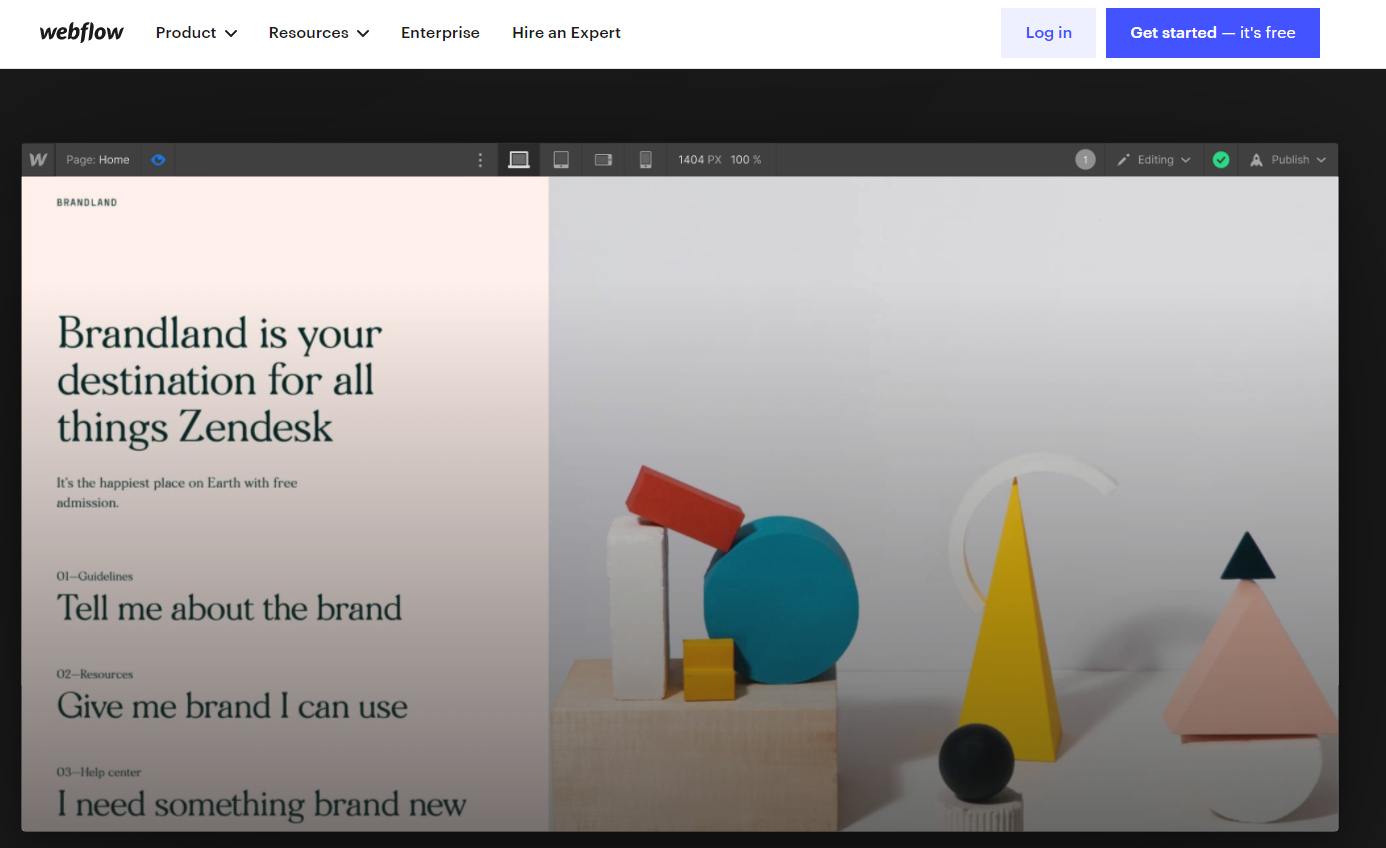We live in a new era, one in which technology has transformed the way we do everything, including creating elegant site designs with just a few mouse clicks.
It’s now easier than ever to build and construct a website from the ground up – and even create designs that defy our imagination.This achievement has been made possible by the invention of website builders.
If you have little or no understanding of how to develop or create a website, a website maker may assist you in accomplishing this goal quickly and easily without the need to learn to code (or even understand basic CSS) – or even break a sweat.
Webflow alternatives available on the market today. There are several solutions available to you. This essay discusses many of these Webflow alternatives and attempts to explain why they are regarded as viable Webflow rivals.
Top Webflow Alternatives Alternatives
Shopify is a major eCommerce SaaS platform that was created specifically to assist online merchants in creating e-commerce sites.
Extrnsive use of application in template makes it easy to work on. However, Shopify is simple than that of those complicated earlier ecom tools.

Wix has become a household brand in the website creation area in recent years. Millions of people worldwide rely on it, and it's easy to understand.
Wix are kings in this industry! 5 stars. Everything is super easy and intuitive.

Squarespace is great for both beginners and specialists, whilst Webflow is better suited to individuals with more knowledge in web design.
When building my online membership business I didn't know where to start, I had a coding background, but enough to build the kind of website I wanted and also had no money to hire anyone. Over the past 3 years I have become even more of a Squarespace believer, have launched several other businesses on the platform.

WordPress are website builders that are deliberately designed to assist you in designing and launching a professional-looking website.
Been using WP from the past many years and deployed many to clients servers. Excellent blogging toolkit with bunch of Free plugins. Good to go for simplified, featured content options.

If you want to make an impression online, use the ideal Webflow choices that assist in the creation of stunning websites.
We live in a new era, one in which technology has transformed the way we do everything, including creating elegant site designs with just a few mouse clicks.
It’s now easier than ever to build and construct a website from the ground up – and even create designs that defy our imagination.This achievement has been made possible by the invention of website builders.
If you have little or no understanding of how to develop or create a website, a website maker may assist you in accomplishing this goal quickly and easily without the need to learn to code (or even understand basic CSS) – or even break a sweat.
The good news is that there are dozens of Webflow alternatives available on the market today. There are several solutions available to you. This essay discusses many of these Webflow alternatives and attempts to explain why they are regarded as viable Webflow rivals.
Ready? Let us begin!
Webflow Alternatives
4 Best Webflow Alternatives:
1. Shopify:
Shopify is a major eCommerce SaaS platform that was created specifically to assist online merchants in creating e-commerce sites.
Its extensive list of built-in capabilities is nothing short of astounding — and that’s before you include in the hundreds of third-party applications you can integrate to optimize your website’s speed.
Additionally, if you have any programming experience, you’ll be thrilled to learn that you may alter the HTML and CSS code for your Shopify site.
By comparison, Webflow’s eCommerce solution is best characterized as a last-minute addition. Initially, Webflow was created just for website creation, but they eventually incorporated a few functions for online commerce.
Webflow and Shopify are equally priced. Therefore, if you’re having difficulty deciding between these two platforms, pricing will not be a significant concern.
Rather than that, whether you choose Webflow or Shopify boils down to your level of web design skill.
If you’re looking for a highly attractive interface with almost limitless customization options, Webflow is an excellent alternative.Nothing is off-limits for customization – product pages, checkout pages, branding components — you name it, it’s editable.
Having said that, Webflow does not provide nearly as many templates as Shopify and does not make the process of launching an online shop particularly straightforward.
To get the most out of this solution, it’s fair to assume that you’ll need to know what you’re doing.
If, on the other hand, you’re looking for a more beginner-friendly experience or a platform that will help you rapidly get your eCommerce shop up and running, Shopify is a far better choice.
2. Wix:
Wix has become a household brand in the website creation area in recent years. Millions of people worldwide rely on it, and it’s easy to understand why.
Whatever kind of project you’re launching, Wix is remarkably simple to utilize. Whether you’re starting a personal website or developing a professional website for your company, it includes everything you need without requiring you to write a single line of code!
Wix is best defined as a cross between a website builder and a content management system.
Why?
That is, it provides both an AI-powered site design alternative and a template-based solution. With the latter, you may alter one of Wix’s many templates manually through the drag-and-drop editor.
Wix’s drag-and-drop editor is what sets it apart from the competition. It’s very straightforward to use and comes equipped with a slew of design customization features to help you realize your idea. Wix’s users also rave about the company’s pricing approach.
There are several possibilities, so you’re certain to discover an economical bundle that matches your requirements. The best part is that there is a free lifetime plan, which is ideal for becoming acquainted with Wix’s UI before committing your hard-earned cash to a subscription program.
Wix, like Squarespace, is an easy-to-use platform. In comparison to Wix, Webflow is significantly more geared at web designers, with a much steeper learning curve. This is possibly why Webflow is not as popular, with around 140,000 active websites globally.
Webflow takes pride in being a completely customizable HTML and CSS website editor. In comparison, Wix is the polar opposite. Wix’s distinguishing characteristic is that users do not need to write any code to make use of it, instead of relying on its website templates and built-in design elements.
Their customer service philosophy is also rather distinct. Webflow places a high premium on itself-help’ documentation; it has a ‘University’ area brimming with lessons and instructions. On the other side, Wix is very simple to reach through email and places a premium on in-person customer service.
3. Squarespace:
When comparing Squarespace vs Webflow, the UI is one of the most noticeable contrasts. Squarespace is far cleaner, which makes it less intimidating to look at, particularly if you’re new to this kind of software.
The UI of Webflow is somewhat more sophisticated. According to others, it has a Photoshop-like feel, with all of its many options and capabilities scattered around the dashboard
While we’re on the subject of usability, it’s also worth emphasizing Squarespace’s great onboarding procedure. Although Webflow provides a comparable service, Squarespace’s is easier.
For example, Squarespace’s language selection is far more novice-friendly. Whereas Webflow’s onboarding process is heavily reliant on jargon, making it more difficult for the uninitiated to grasp.
For instance, they utilize words such as “working with dynamic data in the CMS” – this kind of language is rather difficult (much more so if you’re new to the platform!).
In general, it’s reasonable to conclude that Squarespace and Webflow cater to two distinct customer segments. Squarespace is great for both beginners and specialists, whilst Webflow is better suited to individuals with more knowledge in web design.
Webflow and Squarespace are both reasonably priced. Webflow, on the other hand, provides a greater selection of price levels, as well as a free application. However, despite its wider selection of payment options, Webflow is somewhat more expensive than Squarespace.
Additionally, it’s worth mentioning that Webflow does not issue returns. Squarespace, on the other hand, provides a return term ranging from five to fifteen days, depending on the membership level you choose.
Squarespace and Webflow are comparable in terms of customer care. Both products provide superior customer assistance, including extensive knowledge bases and user-friendly support ticket systems. However, Squarespace offers live chat assistance, which Webflow does not.
4. WordPress:
To begin, both WordPress and Webflow are website builders that are deliberately designed to assist you in designing and launching a professional-looking website.
On the one hand, WordPress.org is the most widely used open-source PHP-based content management system on the market (CMS). It has an astounding degree of adaptability (providing you have the coding know-how to bring your vision to life).
Similarly, if you’re not very tech-savvy, there are a plethora of simple-to-use web design tools and plugins available to extend the functionality of your website. Webflow, on the other hand, is a well-known cloud-based SaaS platform.
While you may not have the same level of customization flexibility as with an open-source system, the breadth of Webflow’s capabilities makes it an outstanding and adaptable CMS. Another significant distinction between the two is that Webflow’s templates have immaculate code.
By contrast, the code for some WordPress layouts (and plugins) is excessively cluttered. Often, this has the unintended consequence of slowing down the pace of your website. Additionally, it’s worth mentioning that Webflow permits on-page editing.
With WordPress, you’ll need to manage all changes from the backend. Alternatively, you may download a third-party page editor to achieve Webflow’s capabilities.
In terms of pricing, Webflow is more costly depending on the subscription plan you pick, while WordPress is completely free. All you need to do is pay for your domain name and hosting. However, if you use premium themes and plugins, you may have to pay a premium price.
Quick Links
FAQs of Webflow Alternatives
Is there anything better than Webflow?
Wix is the most user-friendly website builder on our list, including Webflow, owing to its drag-and-drop editor. Wix enables you to register a domain, design and host your website, as well as create a logo, all in one spot.
Is there a free alternative to Webflow?
Because it is not free, you may like to choose Mobirise or Silex. Squarespace (Paid), Bootstrap Studio (Paid), Wix (Freemium), and Weebly are all excellent alternatives to Webflow (Freemium).
Is Webflow the best website builder?
Webflow is a fantastic website-building software for everyone who enjoys learning. Rather than figuring everything out on your own, you may make use of Webflow University's hundreds of crash course videos. You can now learn how to create a professional website and explore hundreds of free themes with ease.
Does Webflow have a CMS?
Indeed, it does. Webflow CMS enables you to create and amend content directly on your live website, as well as publish with a single click
Conclusion of Webflow Alternatives 2025
Each website construction platform discussed above has distinct advantages and disadvantages. The key to picking the best decision is to consider your business’s requirements, your degree of technical and creative skills, and your business’s future vision.
Bear in mind that the structure you choose now will alter as your firm grows and your demands change.So it’s recommended to choose a powerful, flexible, and least expensive tool.
This will guarantee that your initial expenditure is minimal and that you can be up and running quickly, allowing you to concentrate on your business’s growth and development.













